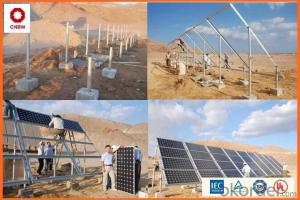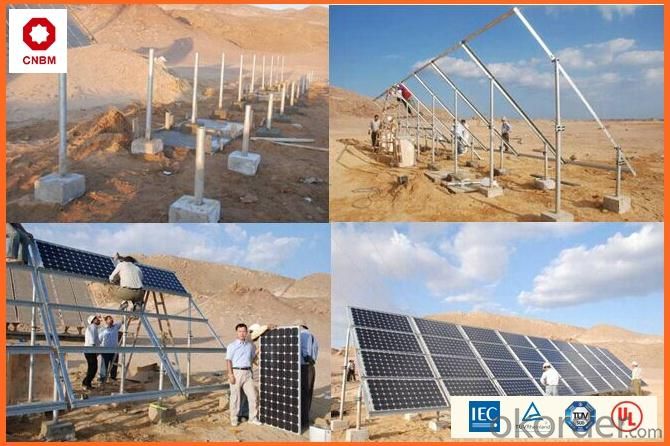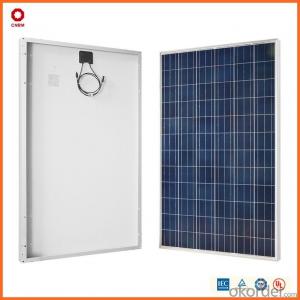General Solar Energy Systems 95w Small Solar Panels in Stock China Manufacturer
- Loading Port:
- China main port
- Payment Terms:
- TT OR LC
- Min Order Qty:
- 1 watt
- Supply Capability:
- 10000000 watt/month
OKorder Service Pledge
OKorder Financial Service
You Might Also Like
Specification
Product Description:
Hot Sale !!! Quality and Safety of Small Poly Solar Panel 5w~150w
1. Rigorous quality control meets the highest international standards.
2. High-transmissivity low-iron tempered glass, strong aluminium frame.
3. Using UV-resistant silicon.
4. IS09001/14001/CE/TUV/UL
Warranties of Small Poly Solar Panel 35~85w
1. 10 years limited product warranty
2. 15 years at 90% of the minimal rated power output
3. 25 years at 80% of the minimal rated power output
Specification
Characteristics of Poly solar panels CNBM (245-320W) | |||||
Max Power Voltage Vmp(V) | 30.3 | 30.8 | 31.1 | 31.4 | 31.85 |
Max Power Current Imp(A) | 7.60 | 7.64 | 7.73 | 7.81 | 7.85 |
Open Circuit Voltage Voc(V) | 36.1 | 36.6 | 37 | 37.3 | 37.68 |
Short Circuit Current Isc(A) | 8.50 | 8.55 | 8.65 | 8.75 | 8.85 |
Max Power Pm(W) | 230W | 235W | 240W | 245W | 250W |
Temperature Coefficient of Cells Poly solar panels CNBM (245-320W) | |
NOCT | 45± 2 |
Temperature Coeffucients of Isc | 0.0492 |
Temperature Coeffucients of Voc | -0.3374 |
Temperature Coeffucients of Voc | -0.4677 |
Mechanical Data of Poly solar panels CNBM (245-320W) | |
Dimension | 1638 × 982 × 40 mm |
Weight | 19.5 kg |
No. of Cells and Connections | 60 (6 ×10) |
Tolerance | 0 ~ + 5 W |
Cell | Monocrystalline Cell 156 × 156 mm |
Packing | 624 Pcs/40ft(H) Container |
Limits of Poly solar panels CNBM (245-320W) | |
Operating Temperature | -40 to +85 |
Storage Temperature | -40 to +85 |
Max System Voltage | 1000VDC(IEC) / 600VDC(UL) |
Features of our products:
• High conversion efficiency mono/poly-crystalline amorphous silicon solar cells
• Modules incorporate high performance bypass diodes to minimize the power drop caused by shading
• High transmittance, low-iron tempered glass
• High performance EVA encapsulant to prevent destroying and water.
• AI frame: without screw, corner connection. 8 holes on the frame can be installed easily
• Good performance of preventing from atrocious weather such as wind and hails
• Certifications: CE IEC TUV VDE UL, Class I
• 10 years 90% power output warranty

Shipping of Small Poly Solar Panel 35~85w
By Sea | Delivery from Shanghai or Ningbo seaport |
By Air | Departure from Shanghai Pudong Airport |
By Express | Post by DHL, EMS, UPS, TNT. |
Features of our products:
• High conversion efficiency mono/poly-crystalline amorphous silicon solar cells
• Modules incorporate high performance bypass diodes to minimize the power drop caused by shading
• High transmittance, low-iron tempered glass
• High performance EVA encapsulant to prevent destroying and water.
• AI frame: without screw, corner connection. 8 holes on the frame can be installed easily
• Good performance of preventing from atrocious weather such as wind and hails
• Certifications: CE IEC TUV VDE UL, Class I
• 10 years 90% power output warranty
As a professional Solar Panel manufacturer and Supplier in China, we have our customers come around the whole world and our specialization has got a worldwide recognition. Meanwhile, with our superior quality, competitive price, prompt and excellent service, As main role in trade section of CNBM Group, CNBM International Corporation supplies products including Monocrystalline Solar Panel, Polycrystalline Solar Panel ( multicrystalline silicon Solar Panel) have received and enjoyed famous reputation in many countries and regions in the world.
- Q: Can solar energy systems be used in areas with high levels of wildlife activity?
- Yes, solar energy systems can be used in areas with high levels of wildlife activity. However, proper measures should be taken to minimize any potential negative impacts on wildlife. This can include designing and installing systems that are bird-friendly, using wildlife-friendly fencing, and ensuring that the installation site does not disrupt important wildlife habitats or migration routes. Additionally, regular monitoring and maintenance can help identify and address any issues that may arise to ensure the coexistence of solar energy systems and wildlife.
- Q: Can solar energy systems be used in powering hospitals or healthcare facilities?
- Certainly, solar energy systems can be utilized to power hospitals and healthcare facilities. Actually, numerous healthcare institutions worldwide are already employing solar power as a dependable and sustainable source of electricity. Solar energy systems consist of photovoltaic (PV) panels that convert sunlight into electricity, which can then be used to operate various equipment and appliances within the facility. There are several advantages associated with using solar energy in healthcare facilities. Firstly, it aids in reducing operational costs by providing a long-term and sustainable electricity source. Hospitals and healthcare facilities require a substantial amount of energy to run medical equipment, lighting, heating, cooling, and other vital systems. By installing solar panels, these institutions can significantly decrease their electricity expenses and allocate their resources towards patient care. Secondly, solar energy systems contribute to environmental sustainability. Hospitals are renowned for their high energy consumption, and traditional energy sources often result in increased carbon emissions and pollution. By transitioning to solar power, healthcare facilities can diminish their carbon footprint and promote a greener and healthier environment. This aligns with the healthcare industry's dedication to advancing public health and well-being. Furthermore, solar energy systems can provide a dependable electricity source, even during power outages or emergencies. Hospitals and healthcare facilities necessitate an uninterrupted power supply to ensure patient safety and well-being. Solar energy systems can be integrated with battery storage solutions, enabling the storage of excess electricity generated during the day for use at night or when there is no sunlight. This ensures a continuous power supply, even during grid outages or natural disasters. It is important to note that the installation of solar energy systems requires careful planning and design to cater to the specific energy needs of hospitals and healthcare facilities. A comprehensive assessment of energy requirements, available space, and system capacity is indispensable to ensure optimal performance and efficiency. Additionally, regular maintenance and monitoring are crucial to ensure the seamless operation of the solar energy system. Overall, solar energy systems offer numerous benefits for hospitals and healthcare facilities. They provide a cost-effective, sustainable, and reliable electricity source, reduce carbon emissions, and contribute to the overall well-being of patients and the environment. As the healthcare industry continues to prioritize sustainability and environmental stewardship, the adoption of solar energy systems in powering hospitals is expected to rise.
- Q: How does the efficiency of solar panels vary across different panel technologies?
- The efficiency of solar panels can vary significantly across different panel technologies. There are several types of solar panels available in the market, each with its unique characteristics and efficiency levels. Firstly, monocrystalline solar panels are known for their high efficiency. These panels are made from a single crystal structure, resulting in a uniform appearance. Monocrystalline panels have the highest efficiency rates, typically ranging from 15% to 22%. The uniform crystal structure allows for better electron flow, maximizing the conversion of sunlight into electricity. On the other hand, polycrystalline solar panels have a lower efficiency compared to monocrystalline panels. These panels are made from multiple silicon crystals, which creates a less uniform appearance. Polycrystalline panels generally have an efficiency range of 13% to 16%. The presence of multiple crystals can cause electron flow to be less efficient, resulting in a slightly lower conversion rate. Another type of solar panel technology is thin-film panels. Thin-film solar panels are made by depositing thin layers of photovoltaic material onto a substrate. These panels have the lowest efficiency rates among the different technologies, typically ranging from 10% to 12%. However, thin-film panels have the advantage of being lightweight, flexible, and less expensive to produce, making them suitable for certain applications where efficiency is not the primary concern. Furthermore, there are emerging technologies like bifacial solar panels and multi-junction solar cells. Bifacial panels have the ability to capture sunlight from both sides, increasing their overall efficiency. Multi-junction solar cells use multiple layers of semiconductors to capture a broader spectrum of light, enabling higher efficiency levels. In summary, the efficiency of solar panels varies across different panel technologies. Monocrystalline panels offer the highest efficiency, followed by polycrystalline panels and thin-film panels. However, it's important to consider other factors such as cost, space availability, and specific application requirements when choosing the most suitable solar panel technology.
- Q: Can solar energy systems be used for air conditioning?
- Yes, solar energy systems can be used for air conditioning. Solar-powered air conditioning systems utilize the sun's energy to generate electricity, which is then used to power the air conditioning unit. This renewable energy source can help reduce electricity bills and minimize the environmental impact associated with traditional air conditioning methods.
- Q: Are there any environmental benefits to using solar energy systems?
- Yes, there are several environmental benefits to using solar energy systems. Firstly, solar energy is a clean and renewable source of power, which means it does not release harmful pollutants or greenhouse gases into the atmosphere, unlike fossil fuels. By reducing our reliance on coal, oil, and natural gas, solar energy helps to mitigate climate change and improve air quality. Additionally, solar panels do not require water for operation, unlike traditional power plants, conserving this precious resource. Overall, solar energy systems offer a sustainable and environmentally friendly solution to meeting our energy needs.
- Q: Can solar energy systems be used for heating and cooling purposes?
- Yes, solar energy systems can be used for heating and cooling purposes. Solar thermal systems can use the sun's energy to heat water or air, which can then be used for space heating or to supply hot water. Additionally, solar-powered air conditioning systems, such as solar cooling systems or absorption chillers, can use solar energy to cool buildings.
- Q: How does a solar thermal system use sunlight to heat water or air?
- A solar thermal system uses sunlight to heat water or air by capturing the solar energy through solar panels or collectors. These panels contain tubes or pipes filled with a heat transfer fluid, such as water or antifreeze. When sunlight hits the panels, the fluid inside absorbs the heat and becomes hot. This hot fluid is then circulated through a heat exchanger, where it transfers its heat to the water or air that needs to be heated. In this way, solar thermal systems harness the energy from sunlight to provide a sustainable and efficient method of heating water or air.
- Q: Can a solar energy system be installed on a mobile home?
- Yes, a solar energy system can be installed on a mobile home. In fact, mobile homes are great candidates for solar installations due to their smaller size and often more flexible roof configurations.
- Q: Can a solar energy system be used in conjunction with other renewable energy sources?
- Certainly, a solar energy system can be utilized alongside other renewable energy sources. In fact, the amalgamation of various renewable energy sources is often referred to as a hybrid renewable energy system, which can yield numerous benefits. By integrating solar energy with sources like wind, hydro, or geothermal energy, a hybrid system can provide a more consistent and dependable power supply. This is due to the different energy generation patterns of each source, and combining them can compensate for any fluctuations or limitations in a specific source. For instance, solar energy production peaks during the day, while wind energy remains relatively constant throughout the day and night. The integration of these two sources ensures a continuous power supply. Moreover, the utilization of multiple renewable energy sources can maximize overall energy production and efficiency. Each source possesses its own strengths and weaknesses, and combining them can amplify the total energy output. This is particularly advantageous in scenarios with high energy demand or when one source alone may not suffice to meet energy needs. Furthermore, a hybrid renewable energy system can enhance energy independence and resilience. By diversifying the energy sources, the system becomes less reliant on a single source, reducing vulnerability to disruptions or failures. This is especially crucial in remote or off-grid areas where access to a reliable power supply is essential. In conclusion, a solar energy system can effectively be used together with other renewable energy sources to create a hybrid system. This approach offers various advantages, including enhanced reliability, improved efficiency, and increased energy independence. By combining multiple renewable energy sources, we can capitalize on their unique strengths and establish a more sustainable and resilient energy system.
- Q: Can solar energy systems be used in areas with high pollution levels?
- Yes, solar energy systems can be used in areas with high pollution levels. While pollution can potentially reduce the overall efficiency of solar panels, they can still generate electricity even in such conditions. Furthermore, using solar energy can help reduce dependence on traditional polluting sources of energy, thereby contributing to mitigating pollution levels in the long run.
Send your message to us
General Solar Energy Systems 95w Small Solar Panels in Stock China Manufacturer
- Loading Port:
- China main port
- Payment Terms:
- TT OR LC
- Min Order Qty:
- 1 watt
- Supply Capability:
- 10000000 watt/month
OKorder Service Pledge
OKorder Financial Service
Similar products
Hot products
Hot Searches
Related keywords






























